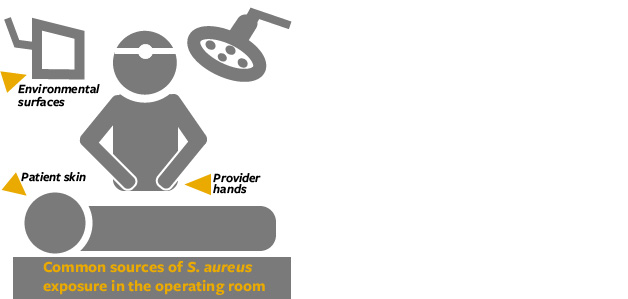Health care-associated infections (HAIs) have been a stubborn issue in the United States for decades, and the rise of drug-resistant bacteria has made the problem even more difficult to tackle. To prevent these infections from taking hold, University of Iowa Health Care researchers tracked how bacteria moved within the operating room (OR) environment.
In a new study published April 27 in the American Journal of Infection Control, Randy Loftus, MD, associate professor of anesthesia in the UI Roy J. and Lucille A. Carver College of Medicine, and colleagues found that routine sterilization procedures between cases in ORs miss a significant amount of infection-causing bacteria – especially those located on provider hands.
Previous studies have linked up to half of surgical site infections to bacteria present in the operating room at the time of surgery. But Loftus notes that the standard practice has been to track such infections retrospectively.
“The patient gets an infection and we try to figure out how it happened. What we wanted to do here was track bacteria transmission from the beginning so we can figure out how to optimize our preventive measures,” he says.
Between 20 and 30 percent of the population persistently carries Staphylococcus aureus, or S. aureus, on the skin and in mucous membranes, such as those in the nose and throat. This type of bacteria typically causes infection when it gets into the blood stream or internal tissues.
Common sources of S. aureus exposure in operating rooms are “not only patient skin sites, but also provider hands,” Loftus and his colleagues wrote. “Perioperative infection control efforts targeting S. aureus should be extended from patient decolonization to include hand decontamination improvement strategies involving all intraoperative providers.”
Ensuring providers follow proper hand hygiene has been a perennial issue in health care settings. According to the Centers for Disease Control and Prevention, health care providers on average clean their hands less than half as often as they should. And, on any given day, about one in 25 hospital patients is affected by at least one HAI.
Loftus’ team studied 40 case-pairs (1st and 2nd cases of the day in each of 40 ORs) over five months, looking for S. aureus. They found colony-forming S. aureus units – enough bacteria to multiply and potentially cause infection – in at least one reservoir location for almost 46 percent of the surgical cases studied.
In almost a quarter of the cases studied, the researchers confirmed S. aureus transmission from one location to another, and the most frequent mode of transmission involved transmission between surgical cases.
“Provider hands, patient skin sites, and environmental surfaces are confirmed sources of perioperative bacterial S. aureus transmission,” Loftus says.
Stopcocks, the valves or plugs that control the flow of fluids through intravenous tubing, are especially problematic because IVs are in direct contact with patients’ blood.
Noting that the average frequency of stopcock contamination hadn’t changed much from 2008, the researchers said this vector for transmission “remains a significant patient safety issue.”
Loftus and his colleagues pointed out several other preventive measures in addition to hand hygiene that are likely to be effective in preventing the spread of infection when combined in a multifaceted approach:
- Improved environmental cleaning, targeting high-risk sites exposed to major bacterial pathogens and more pathogenic strain characteristics
- Using closed, disinfectable stopcocks instead of conventional open devices
- Disinfecting intravascular catheter hubs prior to IV injections
- Improved patient decolonization before and after surgery
- Proactive optimization of the multifaceted approach through regular monitoring, providing meaningful results and process measures necessary to generate improvements
To generate a feedback loop for proactive optimization of infection control measures, the team uses an evidence-based surveillance software called OR PathTrac to monitor bacterial transmission. (Loftus is co-founder, shareholder, chief medical officer, and director of research for RDB Bioinformatics, which owns PathTrac.) The software tracks bacteria from known locations in the operating room and provides real-time information to OR personnel so they can take preventive measures to keep an infection from spreading.
For example, if particular groups of providers are struggling with hand hygiene, steps can be taken at the group level to improve compliance.
And, if lapses in routine and end-of-day cleaning procedures are detected, residual contamination can be mitigated. Automated OR PathTrac reports map OR exposure to major bacterial pathogens and more pathogenic strain characteristics, which can be addressed with targeted deployment of limited resources, such as robotic UVC light. At present, such lapses generally go undetected, increasing patients’ risk of infection, Loftus says.
The paper is Operating room PathTrac analysis of current intraoperative Staphylococcus aureus transmission dynamics by Alysha D.M. Robinson, BS; Franklin Dexter, MD, PhD; Valerie Renkor, BSE; Sundara Reddy, MD; Randy W. Loftus, MD.
